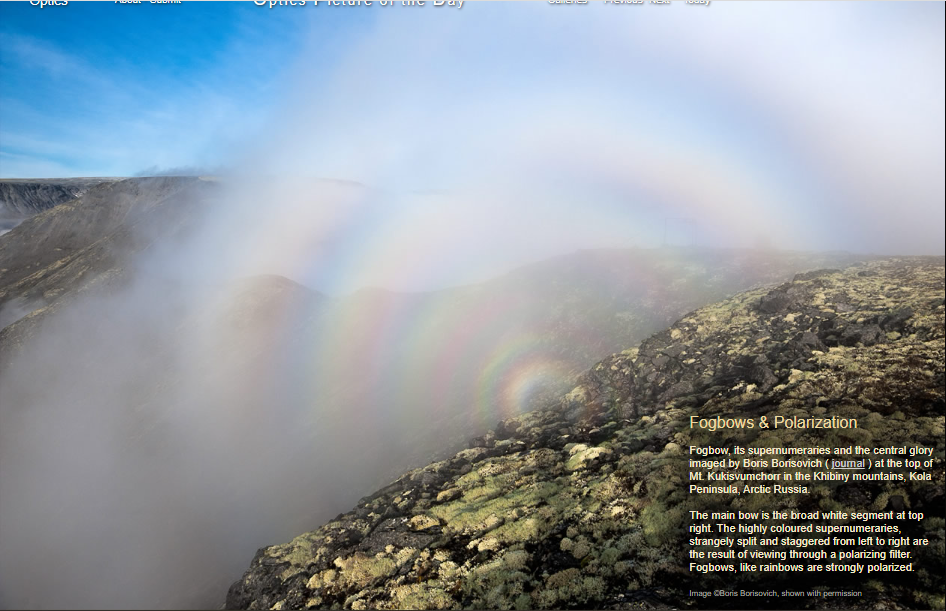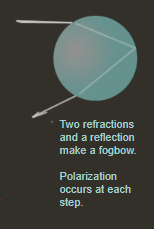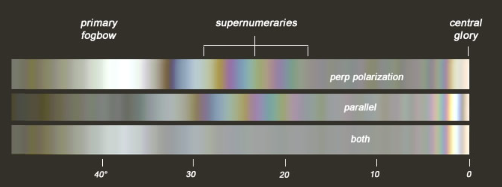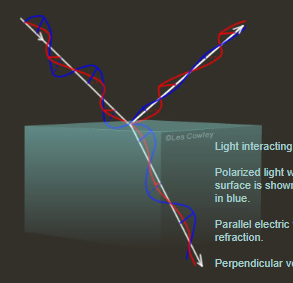Polarized Fogbow, Arctic Russia - OPOD
Polarized Fogbow, Arctic Russia - A Fascinating Atmospheric Phenomenon
Have you ever heard of a polarized fogbow? This mesmerizing atmospheric phenomenon is similar to a rainbow but with a unique twist. Unlike rainbows, fogbows are strongly polarized, which means they exhibit intriguing optical properties when viewed through a polarizing filter. Recently, Boris Borisovich captured a stunning image of a polarized fogbow in Arctic Russia, specifically at the top of Mt. Kukisvumchorr in the Khibiny mountains on the Kola Peninsula.
Unraveling the Science Behind Polarized Fogbows
To understand polarized fogbows, let's first delve into the science of polarization. Light from the sun, known as unpolarized light, consists of oscillating electric fields pointing equally in all directions. However, when this light encounters the watery surface of a fog droplet, something fascinating occurs. The reflected light becomes strongest when its electric fields align parallel to the surface, while the refracted rays into the water are strongest with the fields perpendicular to it. As a result, the light leaving the droplets to form a fogbow and glory becomes polarized.
The Transformative Power of Polarizing Filters
One of the most intriguing aspects of polarized fogbows is how they can dramatically change when viewed through a polarizing filter. Try this experiment yourself! Look at a fogbow (or even a rainbow) through a polarizing filter and rotate it. You'll witness a captivating transformation unfold before your eyes. The colors and patterns shift as the filter rotates, offering a truly mesmerizing visual experience.
The Enigmatic Supernumeraries of Polarized Fogbows
When viewing a polarized fogbow through a polarizing filter, you may notice something peculiar. The supernumeraries, which are additional bands of colors that appear inside the main bow, exhibit an unusual split and staggered appearance. This phenomenon is a result of the interaction between polarized light and the fog droplets. As the polarized light passes through the droplets, it undergoes various interactions, causing the supernumeraries to shift and create a stunning visual effect.
Dissecting the Anatomy of a Polarized Fogbow
To gain a deeper understanding of polarized fogbows, let's dissect their anatomy. When observing a fogbow through a polarizing filter, you'll notice distinct bands that reveal different characteristics of the phenomenon:
- Top Band: This section represents perpendicularly polarized light. The main bow appears strong, accompanied by highly colored supernumeraries that fill the space inside it toward the central glory.
- Center Band: In parallel polarized light, the main bow is nearly absent, and the supernumeraries shift in position.
- Lowest Band: This band showcases the combination of both perpendicularly and parallelly polarized light. The two shifted sets of supernumeraries almost cancel each other out, resulting in a unique visual effect.
Exploring the Science Through Mie Theory Simulations
To better comprehend the behavior of polarized fogbows, scientists rely on Mie theory simulations. By adapting Philip Laven's MiePlot, researchers can simulate the interaction between light and 20-micron diameter fog droplets. These simulations help to explain the intricate patterns and characteristics observed in polarized fogbows.
Conclusion
Polarized fogbows are truly captivating atmospheric phenomena that offer a glimpse into the fascinating world of optics. With their strongly polarized nature, these ethereal spectacles provide a unique visual experience when viewed through a polarizing filter. By understanding the science behind polarization and the interactions between light and fog droplets, we can appreciate the mesmerizing patterns and colors that adorn polarized fogbows. So next time you find yourself surrounded by foggy conditions, keep an eye out for these enchanting natural wonders and be prepared to witness their captivating beauty.

Fogbows & Polarization
Fogbow, its supernumeraries and the central glory imaged by Boris Borisovich ( journal ) at the top of Mt. Kukisvumchorr in the Khibiny mountains, Kola Peninsula, Arctic Russia.
The main bow is the broad white segment at top right. The highly coloured supernumeraries, strangely split and staggered from left to right are the result of viewing through a polarizing filter. Fogbows, like rainbows are strongly polarized.
Image ©Boris Borisovich, shown with permission

Unpolarized light from the sun, electromagnetic radiation, has oscillating electric fields pointing equally in all directions (at right angles to that of travel).
That changes when the light hits the watery surface of a fog droplet.
The reflected light is strongest when its electric fields are parallel to the surface.
Refracted rays into the water are strongest with the fields perpendicular.
Light leaving droplets to form a fogbow and glory is polarized.
Look at a fogbow (or rainbow) through a polarizing filter and it changes dramatically as the filter is rotated � try it!

A Fogbow Dissected
Top band � A section through a fogbow for perpendicularly polarized light. The main bow is strong. Highly coloured supernumeraries fill the space inside it towards the central glory. The right hand of Boris�s image resembles this.
Centre - The main bow is almost absent in parallel polarized light. The supernumeraries are shifted in position. Compare to the left hand of the image.
Lowest band � The two polarizations combined. The two shifted sets of supernumeraries almost cancel.
Use a polarizing filter to see strong fogbow supernumeraries but expect a strange kinked appearance.
Mie theory simulations for 20 micron diameter droplets adapted from Philip Laven�s MiePlot.

Light interacting with a water or glass surface.
Polarized light with its electric vector parallel to the surface is shown in red. Vectors at right angle are in blue.
Parallel electric vectors are weakened by refraction.
Perpendicular vectors are weakened by reflection.
Note: this article has been automatically converted from the old site and may not appear as intended. You can find the original article here.
Reference Atmospheric Optics
If you use any of the definitions, information, or data presented on Atmospheric Optics, please copy the link or reference below to properly credit us as the reference source. Thank you!
-
<a href="https://atoptics.co.uk/blog/polarized-fogbow-arctic-russia-opod/">Polarized Fogbow, Arctic Russia - OPOD</a>
-
"Polarized Fogbow, Arctic Russia - OPOD". Atmospheric Optics. Accessed on April 23, 2024. https://atoptics.co.uk/blog/polarized-fogbow-arctic-russia-opod/.
-
"Polarized Fogbow, Arctic Russia - OPOD". Atmospheric Optics, https://atoptics.co.uk/blog/polarized-fogbow-arctic-russia-opod/. Accessed 23 April, 2024
-
Polarized Fogbow, Arctic Russia - OPOD. Atmospheric Optics. Retrieved from https://atoptics.co.uk/blog/polarized-fogbow-arctic-russia-opod/.